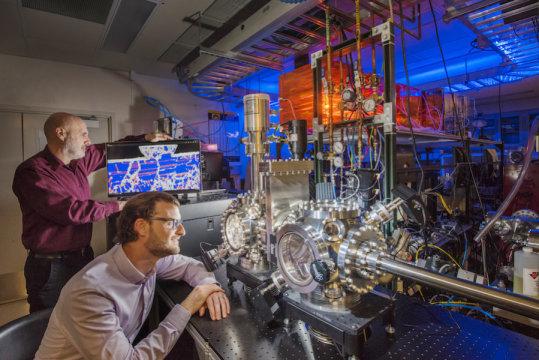- FMA
- The Fabricator
- FABTECH
- Canadian Metalworking
Material engineers develop world's most wear-resistant metal alloy
- November 23, 2018
- News Release
- Metalworking

Sandia researchers Michael Chandross (left) and Nic Argibay show a computer simulation used to predict the unprecedented wear resistance of their platinum-gold alloy. Photo courtesy of Randy Montoya.
A research team at theSandia National Laboratories, Albuquerque, N.M., has engineered a platinum-gold alloy believed to be the most wear-resistant metal in the world.
The material is 100 times more durable than high-strength steel, categorizing it in the same class as diamond and sapphire. Although metals are generally considered strong, when they rub against other metals, they tend to wear, deform, an corrode, unless they include a protective barrier like an additive or coatings, which can be expensive.
"We showed there's a fundamental change you can make to some alloys that will impart this tremendous increase in performance over a broad range of real, practical metals," said materials scientist Nic Argibay, an author on the paper.
The platinum-gold coating could make electronics of all sizes and across many industries more cost-effective, long-lasting and dependable from aerospace systems and wind turbines to microelectronics for cell phones and radar systems.
The alloy is composed of 90 per cent platinum with 10 per cent gold. The Sandia team proposed a new engineering theory that says wear is related to how metals react to heat, not their hardness, and they handpicked metals, proportions and a fabrication process that could prove their theory.
The alloy looks and feels like ordinary platinum, silver-white and a little heavier than pure gold. Most important, it's no harder than other platinum-gold alloys, but it's much better at resisting heat and a hundred times more wear resistant.
The Sandia team describes the results of a remarkable accident. One day, while measuring wear on their platinum-gold, an unexpected black film started forming on top. They recognized it as diamond-like carbon, one of the world's best human-made coatings, slick as graphite and hard as diamond. Their creation was making its own lubricant. Diamond-like carbon usually requires special conditions to manufacture, and yet the alloy synthesized it spontaneously.
Sandia's team recently reported their findings in Advanced Materials.
subscribe now


Keep up to date with the latest news, events, and technology for all things metal from our pair of monthly magazines written specifically for Canadian manufacturers!
Start Your Free Subscription- Industry Events
MME Winnipeg
- April 30, 2024
- Winnipeg, ON Canada
CTMA Economic Uncertainty: Helping You Navigate Windsor Seminar
- April 30, 2024
- Windsor, ON Canada
CTMA Economic Uncertainty: Helping You Navigate Kitchener Seminar
- May 2, 2024
- Kitchener, ON Canada
Automate 2024
- May 6 - 9, 2024
- Chicago, IL
ANCA Open House
- May 7 - 8, 2024
- Wixom, MI



















